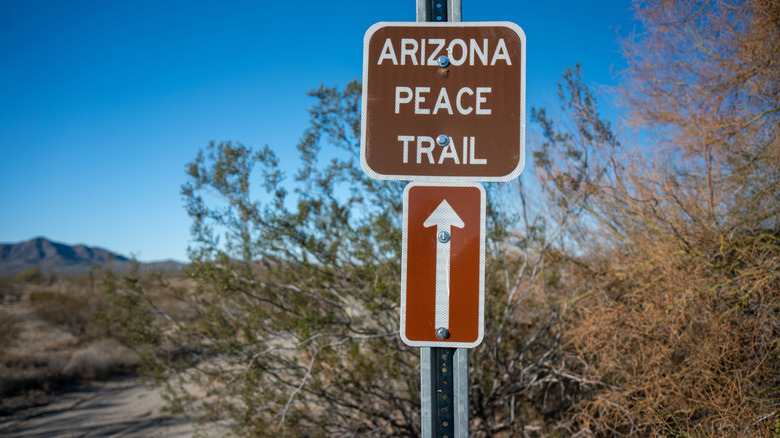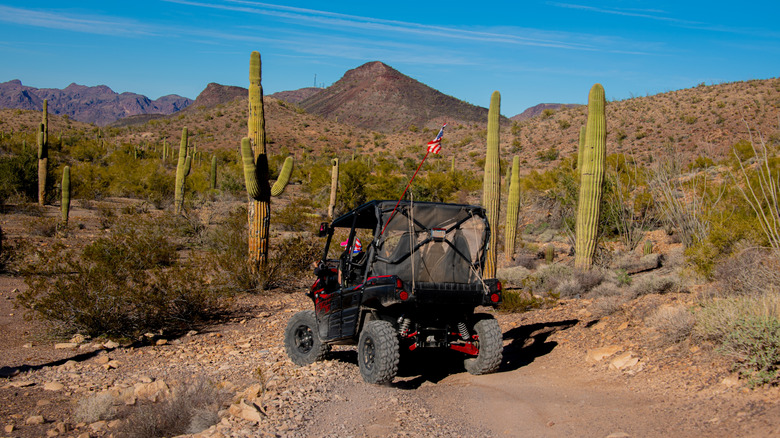The Largest Off-Road Loop Trail In America Is A Rugged Adventure Of A Lifetime
Arizona is known for stunning scenery and epic adventure — after all, it's home to the Grand Canyon, thousands of hiking trails, and a mesmerizing natural wonder shaped like a horseshoe, Horseshoe Bend. But the state also has something you might not even know about: the longest OHV (off-highway vehicle) loop trail in the United States. With good planning, the right equipment, and a crew of fellow off-roaders, this ride on the Arizona Peace Trail could be the bucket-list trip you've been looking for. It's a journey spanning nearly 700 miles through Arizona's diverse landscapes — and it's all thanks to a group of persistent people who saw the opportunity to create something amazing for others to enjoy.
Arizona is home to more than 40,000 miles of off-roading paths, which can make planning a trip like this feel overwhelming. That's what makes this trail so special. The Arizona Peace Trail is a completely mapped loop, supported by a dedicated nonprofit that maintains up-to-date GPS maps and trail-user forums to help riders follow safety and land-use rules, and even organizes group rides for those new to off-road adventures. The trail was officially launched in 2014, when leaders from multiple OHV clubs realized they were each working on similar efforts to connect local trail systems. They combined their efforts to form the Arizona Peace Trail non-profit, collaborating to map, fund, and promote what is now the longest signed OHV loop trail in the country. Their shared vision: to create an epic, sustainable, multi-day ride through some of Arizona's most rugged and scenic terrain. A word of caution — this trip isn't one you'll want to make in the summer months, when temperatures in Arizona soar well above 100 degrees Fahrenheit.
Planning your Peace Trail adventure
A few things to consider when planning your Arizona Peace Trail trip include how much time you want to devote. At 675 miles, the full loop can take up to six days to complete, longer if you take it slow and explore. The trail winds through western Arizona, connecting towns like Yuma, Quartzsite, Salome, Kingman, and Lake Havasu City, allowing you to complete the trip without backtracking. If you don't have that much vacation time, you can break it into sections. Just keep in mind that unless you arrange a pickup, you'll need to double back to your starting point. If you really enjoy exploring ghost towns, World War II artifacts, and old mining equipment, you can research spots and create your journey around the ones you hope to see. An easy stop is the town of Oatman, where you'll find dozens of donkeys roaming the streets, descendants of the working animals that helped Oatman boom during its goldrush heyday.
One great way to experience the Arizona Peace Trail is to hire a guide or join a group ride. The advantage? Logistics are often handled for you with some outfitters even making your hotel reservations. The team at UTV Off-Road Adventures takes it a step further, creating trips that support non-profits through raffles and a poker run.
If you're the DIY type and want the thrill of planning everything yourself, a quick YouTube search will pull up dozens of videos from experienced riders who share terrain tips, packing lists, and vehicle-setup ideas. The Arizona Peace Trail non-profit also has it's own YouTube channel in addition to its Facebook group. This is where some of your most important information will come from, including the official GPS map and a downloadable file with the latest information on what's available in every town along the way. It's important information to have if you need a mechanic, a hotel room, or a place to eat. You'll likely encounter spotty cell service, so be sure you have the map downloaded!
What qualifies as an OHV in Arizona?
What counts as an OHV? In Arizona, any motor vehicle made for trails or unimproved roads is considered an off-highway vehicle (OHV) and must be licensed. That includes ATVs (all-terrain vehicles), trail motorcycles, dirt bikes, and UTVs (utility terrain vehicles), which are often called side-by-sides or SXSs. To ride legally, your OHV needs a state OHV decal. At least one registered owner must complete a safety course before purchasing one. The course is free, takes about 10 minutes, and includes video lessons and a short quiz. The decal itself costs $25 per year (plus a processing fee) at the time of this writing. Out-of-state visitors also need one, and you can take care of it online before your trip on the Arizona Game & Fish Department website. Skip it, and you could face fines — definitely not how you want to start your adventure. The proceeds from this decal go back into the trails for maintenance and a grant program that funds off-road projects.
If you don't have your own off-road vehicle, don't worry — Arizona has plenty of rental options. If you're flying into Phoenix Sky Harbor International Airport, start by checking rental companies in the Phoenix area, which offers the widest range of resources, services, and inventory. If you're driving in, the Arizona Peace Trail Facebook group recommends Paradise Wild Wave Rentals in Lake Havasu City, where you can rent Polaris RZRs with seats for up to six people (and walk along the original London Bridge in Arizona). Rentals can be a pricey option, Desert Experience Off-Road (also in Lake Havasu City), requires a $2,000 security deposit, and daily rates can reach up to $600. Just be sure to research your options and reserve your vehicle well ahead of your trip.


